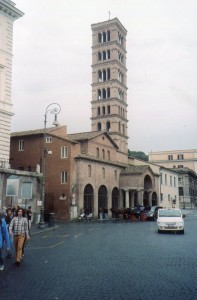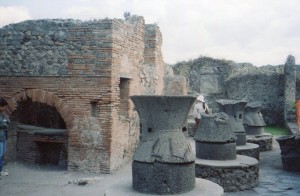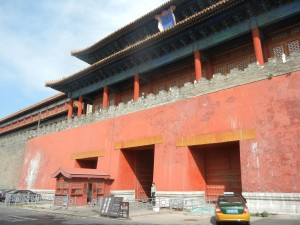By 1CE, Rome and China’s Han Dynasty built the largest empires the world had ever seen. Since they presided over opposite ends of the Eurasian super-continent at the same time, they make a cool intercultural comparison.
The Church of Santa Maria in Cosmedin (above) rises from very deep foundations. Much of ancient Rome’s earliest civic life was centered in its neighborhood. What people have found from Rome’s earliest days says a lot about origins of Western Culture.
Cities back in China’s Shang Dynasty were centered on the royal palace. Trade was less important than it was in the Mediterranean, and kings and their officials directed affairs more from the top-down. But the archeology of the beginning of ancient Rome shows a very different world.
1. Marco Bussagli, in Rome, Art and Architecture, wrote that the key area in Rome’s earliest history was the Forum Boarium (the Cattle Market). The Church of Santa Maria in Cosmedin and the Temple of Fortuna Virlis stand there today. It’s by the Tiber River, and it was thus a convenient place for unloading boats. Fragments of Greek pottery from the 8th century BCE were found there–Greek merchants were already visiting when Rome was supposed to have been founded.
2. Rome grew up in borderlands. Two different cultures called Latins and Sabines rubbed elbows there. A little farther east and south the Oscans ruled a large part of central and southern Italy. The Etruscans held a large chunk of northern Italy, just north of Rome. So the growing city between all these people, and on the river, was a natural trading hub.
3. Romans were conscious of multicultural origins from their earliest days. Their mythical founders, Romulus and Remus, governed a group of men. They needed women to found a lasting state, and proposed to Sabines. They refused because they didn’t want another state muscling in on their territory. So Romans used their real muscles and abducted their women at a festival. They brought them back to Rome and gave them a choice of marrying them and having some rights, or going back.
Ancient Chinese often saw themselves as a single people ruled by an emperor and his officials. Beijing’s Forbidden City’s layout of imposing walls and gates surrounding grand courtyards and huge halls goes back at least 3,500 years, to the Erlitou culture. But Ancient Rome didn’t build any impressive buildings between the 7th and the 1st century BCE–Julius Caesar then constructed his forum.
Romans did build huge systems of city walls, paved roads, aqueducts and sewers, but they were for the general public, not one alpha-male. Scenes of ordinary life, like the bakery in the middle photo of Pompeii, were the most common between the walls.
So Rome’s early experience was similar to Athens’ except Romans were usually more open to letting immigrants in, giving women some rights and allowing freed slaves to become citizens. But both reinforced the general Western experience–reality is more of a multiplicity of distinct places and people than a single field ruled by one king.
But Romans had growing pains that threatened the balance between their many people. In the next post on Ancient Rome, we’ll read that their method of dealing with them strengthened this view of reality even more.




Comments on this entry are closed.